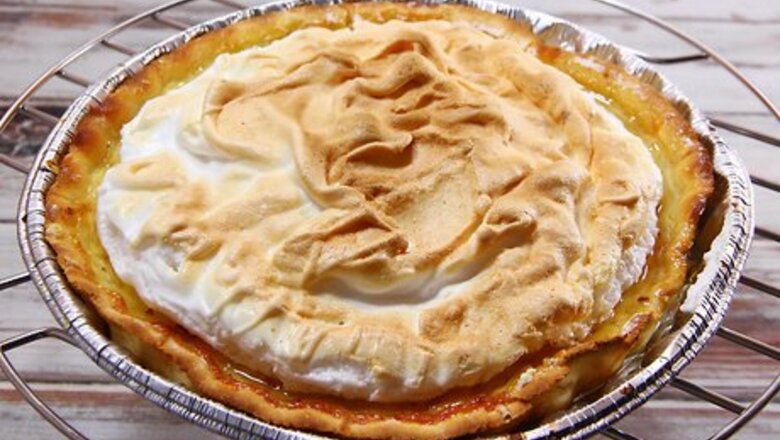
views
Storing Lemon Meringue Pie for Short-Term Use
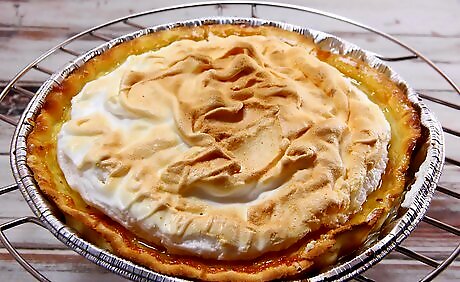
Set the uncovered pie on a rack to cool for 1 hour. When you remove the pie from the oven, set it on a cooling rack to let air circulate above and below the pan. Avoid touching the meringue as it cools, as this can cause the eggs to release moisture. If you don’t have a baking rack, set the pie on a heat-resistant pot holder while it cools to protect your countertops from scorching.
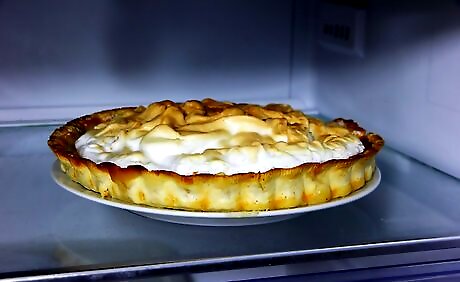
Place the uncovered pie in the refrigerator for 3-6 hours. After cooling the pie to room temperature, move it to the refrigerator. Lemon meringue pie should always be chilled before serving. Make sure the pie is on a top shelf to prevent other items in the refrigerator from spilling or dripping on the pie. Avoid putting any plastic wrap or foil over the pie if you’re refrigerating it for less than 6 hours. Covering the pie with a wrap can crush the meringue, causing it to release moisture and get runny, which is called “weeping.”
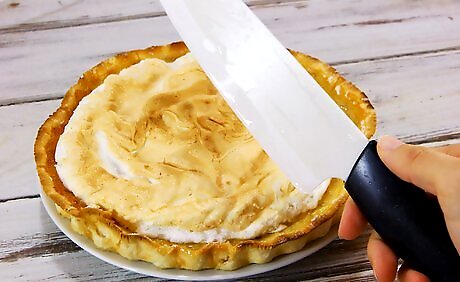
Cut the pie with a wet knife after cooling it for at least 3 hours. Remove the pie from the refrigerator when you’re ready to serve it. To get a clean cut, dip a knife in cool water before cutting the pie to prevent the meringue from sticking to the knife. If it’s a humid day, you may notice that the meringue produces water immediately after you remove it from the refrigerator. This is normal, and you can still cut and serve the pie.

Avoid storing the pie outside of the refrigerator for more than 2 hours. Once you’ve served a few slices of the pie, return the remaining pieces to the refrigerator to prevent bacteria growth. Never leave the pie sitting at room temperature for long periods of time. If the pie has been sitting out for longer than 2 hours, it’s best to throw away the remaining pieces to prevent foodborne illness.
Refrigerating the Pie for Long-Term Storage
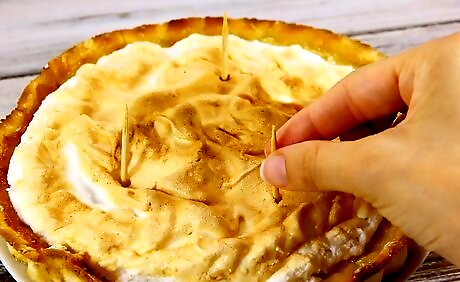
Insert 3 toothpicks into the pie to support the plastic wrap. Push the toothpicks about halfway between the center and crust so that they stick out about ⁄2 inch (1.3 cm) above the meringue. Position them in a triangle shape to ensure that all of the sides of the pie will be protected when you add the plastic wrap. The toothpicks help to hold the plastic wrap up and away from the meringue. If the plastic is too close to the meringue, the combination of eggs and water will begin to weep and release water, making the meringue look runny. If you have a particularly large pie, you may need to use 4 or 5 toothpicks distributed throughout the pie.
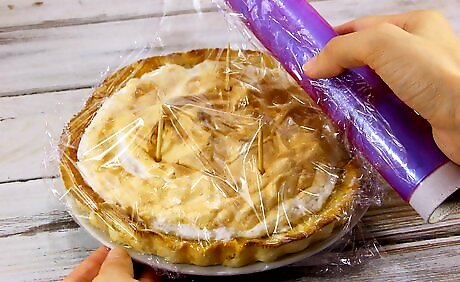
Drape a piece of plastic wrap over the toothpicks and pie. Leave the pie in the pan or transfer it to a plate, and get a piece of plastic cling wrap that’s large enough to cover the pie. Then, carefully lay the plastic on top of the toothpicks so they don’t puncture the plastic. Fold the edges of the cling wrap around the outside of the pan or plate. If one of the toothpicks tears or punctures the cling wrap, throw the piece away and get another one to use.
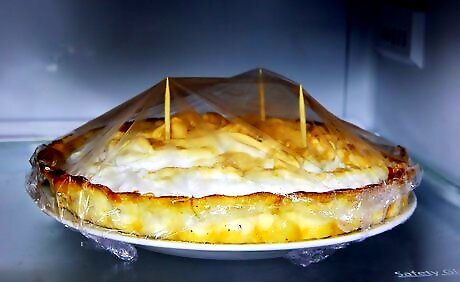
Store the pie in the refrigerator for up to 3 days. Transfer the pie to the refrigerator, being careful not to pull on the cling wrap. Place the pie on the top shelf where you can keep it for a few days before enjoying it. After 1-2 days in the refrigerator, replace the plastic wrap with a new piece. If you need to take the pie out of the refrigerator at any point, be careful not to pull or poke the plastic wrap, as this can cause the toothpicks to break through the plastic.
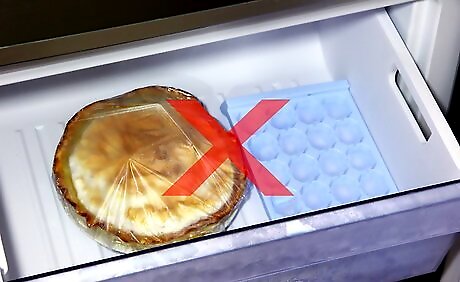
Avoid placing the pie in the freezer at any point. Meringues are made of eggs and sugar, so they don’t freeze well. If you do put the meringue in the freezer, it can become flat or crunchy, ruining the texture of your pie. Most meringues tend to break down in the freezer, resulting in a pie with a crunchy, icy texture. You can, however, prepare and store the lemon filling and crust in the freezer for a few months. Then, when you’re ready to serve the pie, remove the premade filling and crust from the freezer and bake the rest of the pie as normal.
Preserving the Meringue
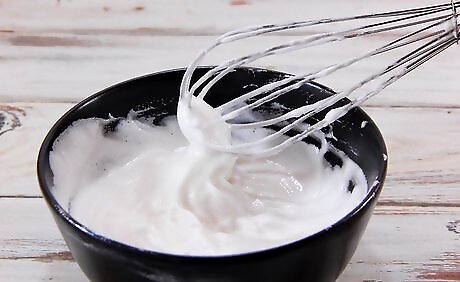
Add the meringue to the pie 10 minutes after you take it out of the oven. Prepare the meringue while the lemon filling and crust are baking in the oven. When you take the bottom portion of the pie out of the oven, wait a few minutes for the lemon filling to cool slightly to avoid overbaking the meringue. The heat from the filling will begin to cook the meringue, making it less likely to shrink or weep
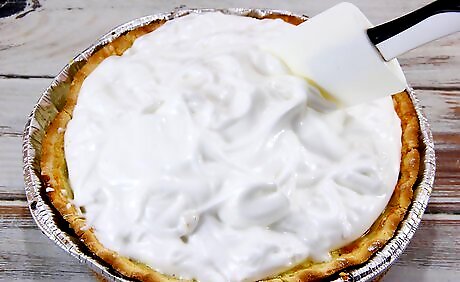
Spread the meringue across the pie so that it’s touching the crust. Use a spoon or spatula to distribute the meringue over the top of the pie. Around the edge, press the meringue outward slightly to make sure it’s touching the crust all the way around the pie, which “seals” the meringue to prevent weeping. It may be easier to use a toothpick or a fork to spread the delicate meringue around the edges. Just be careful not to stick the toothpick all the way into the pie before it’s baked, which can cause the lemon filling and meringue to mix.
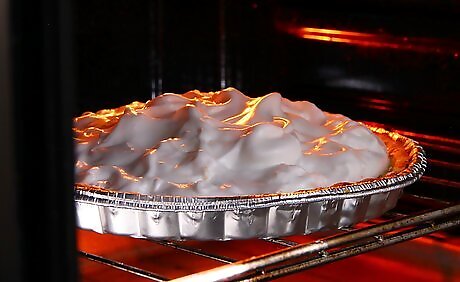
Watch the pie while it’s in the oven to avoid overbaking. At the minimum baking time, pull the meringue out of the oven to check if it’s done. If it is, let it cool and chill. If not, put it back in the oven for increments of 2-3 minutes at a time to finish baking. On a pie, a cooked meringue will have a slight brown tint but still be soft and fluffy. If you begin to see small drops of water on the meringue when you take it out of the oven, stop baking the pie immediately.


















Comments
0 comment